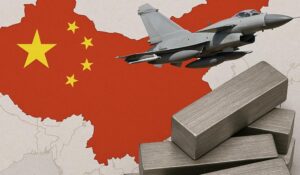Subscribe for Investment Insights. Stay Ahead.
Investment market and industry insights delivered to you in real-time.
- US Department of Defense plans to purchase $1 billion in critical minerals to secure supply for defense and energy systems
- move reflects rising concern over US reliance on foreign refining, where China controls 60–95% of global processing
- strategy marks a shift from “market-led” sourcing to state-directed resource security in the US
The US Department of Defense is preparing to purchase $1 billion worth of critical minerals to build a national stockpile and shield military supply chains from geopolitical disruption, according to a report by the Financial Times.
The plan would represent one of the largest US strategic mineral purchases since the Cold War, aiming to ensure secure access to metals used in fighter jets, missile systems, hypersonic weapons, electric vehicles and advanced manufacturing.
The Pentagon stockpile purchases would include buying US$500 million of cobalt, US$245 million of antimony, and US$100 million of tantalum.
The initiative is being coordinated under the Defense Production Act and will prioritise rare earth permanent magnets, battery-grade graphite, cobalt and nickel sulphates, and aerospace-grade titanium, according to officials briefed on the program.
“They [the US defence department] are incredibly focused on the stockpile… They’re definitely looking for more, and they’re doing it in a deliberate and expansive way, and looking for new sources of different ores needed for defence products” — one former defence official told the FT.
Why it matters
The US currently imports over 80% of its critical minerals and is almost entirely reliant on foreign refining capacity, according to the U.S. Geological Survey. The International Energy Agency estimates that China controls 90% of rare earth refining, 84% of nickel sulphate production, 70% of cobalt refining and 62% of graphite processing.
The Pentagon’s decision signals a structural shift in how mineral supply chains are treated in Washington — no longer as commodity markets, but as strategic assets.
Why stockpile critical minerals?
– stockpiling reduces supply risk latency during conflict or trade disruption
– a physical buffer ensures continuity of weapons and missile production
– stockpiles also anchor domestic supply chain investment
Why now?
The move follows a series of policy escalations in 2024–25:
- The U.S. added 29 minerals to its strategic materials list (US DoD, 2025)
- The National Defense Industrial Strategy made mineral independence a “priority objective”
- The Energy Act formalised U.S. government authority to fund critical mineral production
Meanwhile, global demand is surging. The IEA forecasts critical mineral demand will double by 2030, driven by electrification and defense rearmament (IEA, 2024).
Stockpiling is becoming common among major economies:
- EU Critical Raw Materials Act includes strategic reserves
- India launched a National Mineral Security Strategy in 2025
- Japan maintains rare earth reserves equivalent to several months of supply
Who supplies the US?
While the Pentagon did not name supply partners, US security policy increasingly prioritises “allied sourcing” over open-market purchasing. This means procurement will likely favour North America, Australia and select African jurisdictions aligned with Western security cooperation.
This aligns with the Minerals Security Partnership (MSP), a US-led initiative spanning the UK, EU, Japan, South Korea and Australia to co-invest in alternative supply chains.
Conclusion
The US is not waiting for market-led solutions to secure mineral supply. The $1 billion stockpile plan is a strategic hedge against a world where resource security now shapes industrial and defense policy. It is the clearest signal yet that critical minerals have moved from trade to strategy — and governments, not markets, will increasingly decide where supply flows.
Our recent analysis on whether the US match China’s critical mineral stockpiles?




















